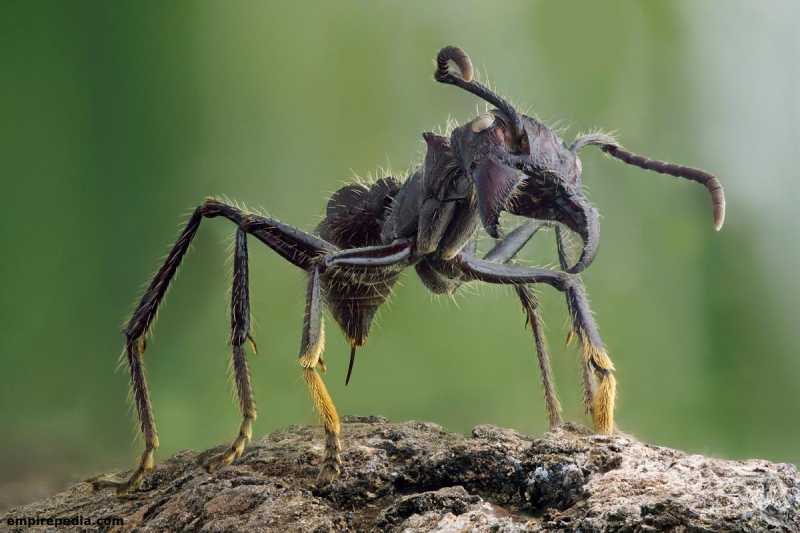In the dense, green expanses of the rainforests of Central and South America, one creature commands both awe and panic—the bullet ants, scientifically known as Paraponera clavata. Known for its excruciatingly painful sting, this remarkable insect encompasses a world of intrigue, marked not only by its venomous power but also by its complex social structure, evolutionary significance, and cultural symbolism.
As denizens of the forest floor, these reddish-black ants, similar to wingless wasps, exist within precisely formed colonies that display both predatory prowess and a complex communication system. Beyond their fearsome reputation, bullet ants are woven into the rich tapestry of the rainforest, playing an important role in their ecosystems and embedded in the cultural narratives of local communities. Understanding the mysterious world of bullet ants reveals not only the raw power of their sting but also the depth of their ecological importance and cultural significance within their lush forests.
Taxonomy and Classification of Bullet ants:
The taxonomy and taxonomy of bullet ants, formally known as Paraponera clavata, illuminates their evolutionary journey and their distinct position in the complex web of ant species. Belonging to the genus Paraponera and standing as the only living species within the subfamily Paraponerinae, these ants have a taxonomic legacy that spans centuries. Their taxonomy not only reveals a single species but also provides insight into their moral traits, behavior, and evolutionary adaptations.
By carefully examining their club-shaped bodies, size variations, and unique characteristics among worker ants, scientists have identified their taxonomic distinctions within the broader ant family Farmacidae. This classification underscores their evolutionary importance, highlighting their adaptive features and ecological roles within their diverse rainforest ecosystems. Through a taxonomic lens, the taxonomy of bullet ants not only delimits their taxonomy but also reveals a deeper understanding of their place in the evolutionary history of ants.
Morphology and Physical Characteristics:
The shape and physical characteristics of bullet ants, Paraponera clavata, paint a vivid portrait of their remarkable adaptations and unique traits in the ant world. Measuring between 18 and 30 mm, these ants sport a robust, reddish-black body like wingless wasps, giving them a distinct appearance from their ant counterparts. Their robust body, along with the absence of polymorphism within the worker caste, distinguishes them in the complex hierarchy of ant colonies.

Notably, their imposing size makes no apparent difference in queen ant dimensions, a feature in contrast to many other ant species. Their predatory nature and defensive abilities are reflected in their loud calls and venomous stings, earning them the nickname “bullet ants”. Amazingly, their shapes, characterized by their club-shaped features and other physical attributes, illustrate their adaptability and evolutionary potential within the dense rainforest ecosystems where they thrive. A meticulous study of their morphology offers a glimpse into the special adaptations and distinctive traits that define these robust yet fascinating creatures within the rich tapestry of ant diversity.
Distribution and Habitat:
The distribution and habitat preferences of bullet ants, scientifically known as Paraponera clavata, traverse the lush landscapes of the rainforests of Central and South America, marking their presence in diverse geographic ranges. Their wide distribution extends from the northern regions of Honduras, El Salvador, Nicaragua, Costa Rica, and Panama to the southern regions of Venezuela, Colombia, Ecuador, Peru, Bolivia, and Brazil.
Within this wide range, bullet ants make their existence in the wet Neotropical realm, thriving primarily in humid lowland rainforests. These resilient creatures establish nesting colonies at the base of trees, seeking refuge in the green canopies of the forest floor and shelters embedded in roots. Their adaptability is reflected in their ability to tolerate different altitudes, as they have been documented at altitudes up to about 750 meters (2,461 ft) above sea level.
Foraging Primarily in the upper canopy, pill ants exhibit an aquatic orientation, collecting nectar and small arthropods as their preferred diet. Despite their adaptable nature, they show a minimal selection of nesting sites, preferring trees with distinctive features such as buttresses and extrafloral nectaries. This complex relationship with their habitat not only illustrates their resilience within different ecosystems but also highlights their role as integral members of the complex rainforest landscape.
Behavior and Social Structure:
The behavior and social structure of the bullet ant, Paraponera clavata, unveils a carefully organized society interwoven with complex communication and defense mechanisms. Within their colonies, which consist of several hundred individuals, an organized social order is established. Unlike many ant species, bullet ants lack polymorphism among worker ants, exhibiting relatively uniform size and appearance across the caste.
Their foraging patterns show an aquatic bias, as workers sift the upper canopy for nectar and small arthropods, taking this valuable resource back to their nests. Communication within the colony relies on an elaborate system, with ants using various chemical cues and physical cues to convey information about food sources or potential threats. Despite their non-aggressive nature, these ants show extraordinary ferocity when defending their nests.
They make annoying sounds and deliver a sting that has earned them their infamous reputation, often likened to the pain of a gunshot wound. This collective defense mechanism highlights their unity and collective strength in the face of threats. The behavioral intricacies of bullet ants offer a glimpse into their disciplined and organized society, reflecting their survival strategies and their critical role in complex rainforest ecosystems.
Predatory nature and interactions:
The predatory nature of bullet ants, Paraponera clavata, makes them intricately woven into the fabric of rainforest ecosystems, reflecting their important roles as skilled hunters and interactive members of their environment. As powerful predators, bullet ants exhibit a voracious appetite for small arthropods, which actively forage within the upper canopy of the rainforest.
Their predatory behavior goes beyond simply foraging. They have been documented as antagonists of the glasswing butterfly (Greta Otto), engaging in interactions where the butterfly larvae produce chemical secretions that repel ants due to their unpleasantness. However, such interactions indicate a complex relationship, in which species within forests coexist and develop adaptive mechanisms to navigate their ecological niches.
Additionally, bullet ants face their own adversaries, such as the phorid fly Apocephalus paraponerae, a parasite that targets wounded worker ants. This complex web of interactions, where predators and prey develop common strategies for survival, highlights the interconnectedness of species within forest ecosystems and the important role that bullet ants play as both predators and participants in this complex ecological tapestry.
Venom and Sting:
The venom and sting of the bullet ants, scientifically known as Paraponera clavata, stand out as a special feature that has earned them a notorious reputation. Their venom, encapsulated within their powerful sting, causes excruciating pain that puts them at the top of the Schmidt sting pain index. The venom, combined with poneratoxin, a neurotoxic peptide, induces waves of throbbing pain that are likened to walking on burning charcoal with a nail embedded in the foot.

The effects of a sting can persist for up to 24 hours, with symptoms such as lymphadenopathy, edema, tachycardia, and, in severe cases, the appearance of fresh blood in the human victim’s stool. The venom targets voltage-dependent sodium ion channels, paralyzes the nervous system, and has attracted attention in clinical research for potential applications due to its neurotoxic properties.
Despite its discomfort, the venomous sting has evolutionary significance, serving as a defense mechanism for the ant and reflecting its place as a formidable predator within the complex ecosystem of rainforests.
Cultural Significance:
Beyond their ecological role, bullet ants have cultural significance. Among the Sateré-Mawé people of Brazil, deliberate bullet ant stings are part of initiation rites, symbolizing bravery and strength. These rituals, which include wearing gloves filled with angry ants, mark puberty or a change in leadership.
Conclusion:
The world of bullet ants, Paraponera clavata, is a fascinating combination of resilience, complex behavior, and critical ecological importance within the rainforests of Central and South America. Their taxonomic uniqueness, special traits, and important role in rainforest ecosystems make them fascinating creatures. From their preference for humid rainforests to their fearsome stings and cultural symbolism, these ants strike a delicate balance of fear and admiration.
Preservation of their habitats becomes critical amid environmental threats, highlighting the importance of biodiversity conservation. Bullet ants stand as a reminder of the complex connections between species and their environments, urging us to protect these natural wonders for future generations.
Also, read The Most Intriguing Collective Ant Species










